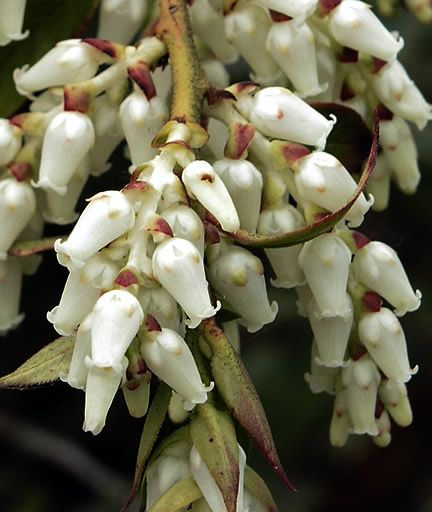| General Description | This colonizing shrub takes 15 - 20 years to reach its full size. It has graceful, arching branches, interesting, variegated leaves and small, urn-shaped flowers blooming on long racemes dangling below the leaves. |
| ID Characteristic | Variegated leaves are long, sharply pointed and have fine, wide-spread serrations. Thick basal branches arch with minimal lateral branching. |
| Shape | Fountain-like. |
| Landscape | This understory shrub can be used in naturalizing, mass plantings or as a specimen plant. Also good for bank stabilization and erosion control. |
| Propagation | Best propagated by cuttings as seeds may not be true to form. To increase the success rate treat summer cuttings with 1000 ppm IBA and winter cuttings with 3000 ppm IBA with an excellent success rate. Untreated cuttings take slightly longer to establish. |
| Cultivation | Grow in a sheltered location; part to full shade; moist, well-drained, highly organic, slightly acidic soil. It is intolerant of full sun and requires protection from winters drying winds. Rejuvenate in spring by hard pruning right to the ground. Container grown specimens transplant with high success rates. |
| Pests | Very susceptible to defoliation by leaf spot. Even the healthiest of plants grown in optimal conditions may contract this disease. Root rot that distorts growth, can also be problematic. |
| Notable Specimens | Mount Allison University, Sackville, New Brunswick, Canada. |
| Habitat | Horticultural origin. |
| Bark/Stem Description | Thin, shiny and very smooth. Ranges in colour from greenish to red and even purplish. |
| Flower/Leaf Bud Description | Conical, red, 2.5 cm long, scales are sharply pointed. |
| Leaf Description | Simple, alternately arranged, 2 ⨉ 10 cm, leafstalk 80 mm long. Ovate to lanceolate, leathery, slightly glossy and glabrous. New foliage emerges with pink, white and copper variegation, maturing to a creamy green variegation. May turn deep burgundy or bronze during winter. |
| Flower Description | Slightly urn-shaped, white and off-scented, borne on 5 - 7 cm long, pendulous racemes. Can be hidden by the foliage. |
| Fruit Description | Five-valved capsule, opening upon maturity, 40 mm in diameter, brown when ripe. |
| Colour Description | Bark can range from green to red and even purplish, while on new growth, stems are brilliant red. Foliage emerges with pink, white and copper variegation and subsides to a creamy green variegation. Leaves often turn a deep burgundy or bronze during winter. Flowers are white while the fruit is brown when ripe. |
| Texture Description | Medium throughout all seasons. |
